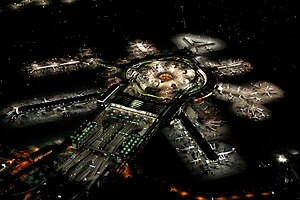
International airport
Airport with facilities for international travel (border control and customs) / From Wikipedia, the free encyclopedia
Dear Wikiwand AI, let's keep it short by simply answering these key questions:
Can you list the top facts and stats about International airports?
Summarize this article for a 10 years old
An international airport is an airport with customs and border control facilities enabling passengers to travel between countries around the world. International airports are usually larger than domestic airports, and they must feature longer runways and have facilities to accommodate heavier aircraft such as the Boeing 747 and the Airbus A380 commonly used for international and intercontinental travel. International airports often also host domestic flights, which often help feed both passengers and cargo into international ones (and vice versa).

Buildings, operations, and management have become increasingly sophisticated since the mid-20th century, when international airports began to provide infrastructure for international civilian flights. Detailed technical standards have been developed to ensure safety and common coding systems implemented to provide global consistency. The physical structures that serve millions of individual passengers and flights are among the most complex and interconnected in the world. By the second decade of the 21st century, over 1,200 international[citation needed] airports existed with almost two billion[citation needed] international passengers along with 50 million[citation needed] metric tonnes of cargo passing through them annually.